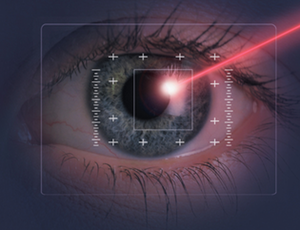Landmarks—Ruby Red Laser Light Becomes Ultraviolet
Landmarks articles feature important papers from the archives of the Physical Review journals.
Just a year after the invention of the laser in 1960, a team of physicists reported a simple experiment that doubled the frequency of laser light, creating ultraviolet radiation from red. This was the first demonstration of a nonlinear optical phenomenon—one in which the intensity of the light leads to effects beyond those explained by standard electromagnetic theory. Today nonlinear optics are used to generate x-ray laser radiation, boost power in optical data transmission, and produce high-intensity pulses for surgery.
In classical electromagnetism, the refractive index of a transparent material is related to its polarizability—the degree to which an applied electric field generates an internal polarization field (analogous to the magnetism generated by a magnetic field). If the applied field is weak, the polarizability is effectively directly proportional to the applied field. But for a strong electric field, nonlinearity can become important, meaning that the polarization may be a sum of terms depending on the square and higher powers of the electric field. In 1961 researchers knew of this nonlinear effect for strong, static fields, but no one had seen it produced by the field of an intense electromagnetic wave.
Although the intensity of the first ruby lasers was low by today’s standards, Peter Franken and his colleagues at the University of Michigan in Ann Arbor realized that by focusing a laser pulse, they could produce a localized electric field strength of volts per meter or more. That should be enough, they thought, to produce detectable nonlinear effects.
To investigate this possibility, Franken wrote down an equation in which the polarization depended on the square of the electric field as well as the usual linear component. Since the square of a sine wave can be written in terms of sine waves of twice the frequency, Franken concluded that passing a sufficiently strong laser beam through a suitable material would generate a harmonic (frequency-doubled version) of the original signal. Doubling the frequency of light from a ruby laser would mean halving its wavelength from nanometers (nm), in the red part of the visible spectrum, to about nm, in the ultraviolet part. The intensity of this second harmonic would depend on the magnitude of the nonlinear response.
Franken intended to try an experiment using glass or fused quartz as the nonlinear medium, recalls his coauthor and Michigan colleague Gabriel Weinreich, but he had overlooked a crucial theoretical wrinkle. Weinreich told Franken that there would be no frequency doubling in these materials because of their high symmetry. In such a material, projecting every atom through a center of inversion is equivalent to reversing the sign of the applied field and the induced polarization. But any part of the polarization that is proportional to the square of the electric field would not change sign. The only way to respect both conditions would be for the squared term—the one responsible for the frequency doubling—to be zero.
Franken, Weinreich, and their colleagues therefore decided to try a single crystal of quartz, an anisotropic material. They focused light from a ruby laser onto a point inside the crystal and used a spectrometer to analyze the light emerging from the other side. A photographic plate showed a large spot corresponding to light at the original frequency and a faint spot at twice the frequency. To verify that this was indeed the second harmonic of the laser light, they showed that it did not appear when they replaced the quartz crystal with a piece of glass. Ironically, the faint spot did not appear in the figure in Physical Review Letters because someone at the printing company thought it was a blemish and erased it, says Weinreich.
Herbert Winful, a University of Michigan optics researcher who was not associated with the original work, says that investigation and technological uses of nonlinear optical effects began to take off as lasers became powerful. Higher-order frequency multiplication, up to the th harmonic, can generate coherent radiation in the extreme ultraviolet and x-ray regimes. Nonlinear effects generate entangled photon pairs that exhibit quantum optical phenomena. More generally, Winful adds, Franken’s work spurred investigation of a wide variety of nonlinear effects. For exampler, materials whose refractive index varies with light intensity make possible the ultrashort pulses of femtosecond lasers, which are used in surgery and micromachining.
This research is published in Physical Review Letters.
–David Lindley
David Lindley is a freelance science writer in Alexandria, Virginia.





